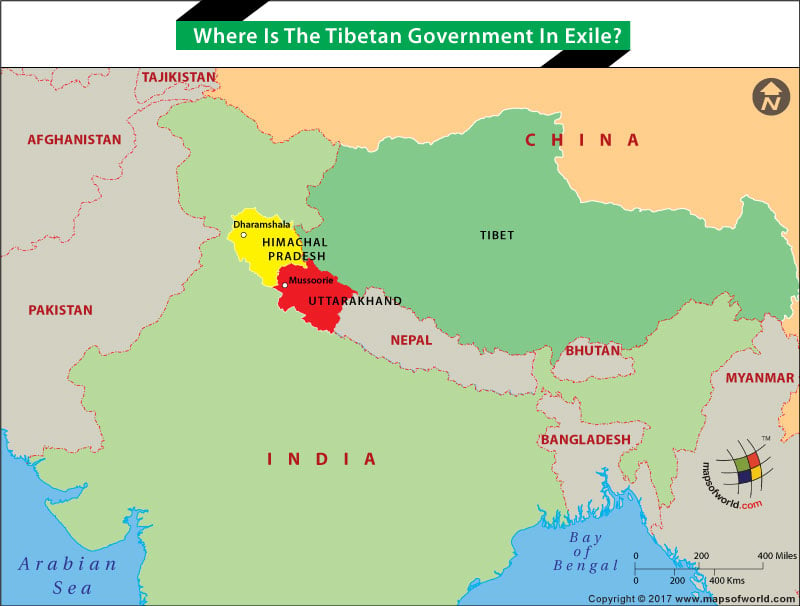Where is the Tibetan Government in Exile?

The Central Tibetan Administration (CTA) also known as the Tibetan Government in Exile was established in Mussoorie (state of Uttarakhand), in India on April 29, 1959. The following year, however, its headquarter was moved to Dharamsala (state of Himachal Pradesh), India. Dharamsala is near the famous tourist destination, McLeod Gunj. The seat of the CTA is called Gangchen Kyishong meaning ‘happy valley of snow’ in the Tibetan language.
The status of Tibet’s sovereignty or lack thereof is a matter of much contention and dispute not only for the people of Tibet and for the Chinese government but also for countries such as India, Nepal, and Bhutan which maintain historic socio-cultural ties with Tibet and with the Dalai Lama. While the Chinese claim that Tibet has historically remained an inalienable and important part of China, the Tibetans believe that through history, Tibet has remained an independent country. At the time of the Xinhai Revolution (1911-12), however, Tibet was a part of China. With the end of monarchy Tibet declared its independence in 1913. The republican government of China did not recognize this call for independence despite Tibet’s autonomy. The Battle of Chamdo (1951) once again brought Tibet under Chinese Territory and in the subsequent years the clashes between the dissident Tibetans who only accepted the authority of the Dalai Lama and the Chinese troops grew worse. Sensing that he might be abducted or murdered, the 14th Dalai Lama (spiritual and political leader of Tibet) undertook a dangerous flight to India on March 17, 1959. He was granted asylum in India and soon after the Tibetan government-in-exile was formed in India.
According to this Tibetan Government-in-Exile or the Central Tibetan Administration (CTA), there are over 145,150 Tibetans who were forced to flee their land and now live in exile all over the world. About 101,242 of them live in India, about 16,313 in Nepal, 1,883 in Bhutan and the rest in other countries. The head of the state according to the exiled Tibetans is the Dalai Lama. The Tibetan Parliament-in-Exile (TPiE) is democratically elected and elections are held every five years. It consists of 46 members ( 43 are elected directly and 3 are nominated by the Dalai Lama himself). The Kashag is the Cabinet or the executive body of the government. The Sikyong (formerly Kalon Tripa) or chief executive and other members of the government are elected for a term of five years. The government runs a number of departments such as Religion and Culture, Home, Security, Information and International Relations, Finance, and Health. The Tibetan Supreme Justice Commission is the chief judicial body of this government and the Charter of Tibetans in Exile acts as the main constitutional document of the Tibetans in exile.
The CTA works tirelessly to ensure the survival and independence of the Tibetan people. In recent years, however, the Dalai Lama has been pursuing the goal of autonomy for Tibet within Chinese sovereignty.
Related Maps:




